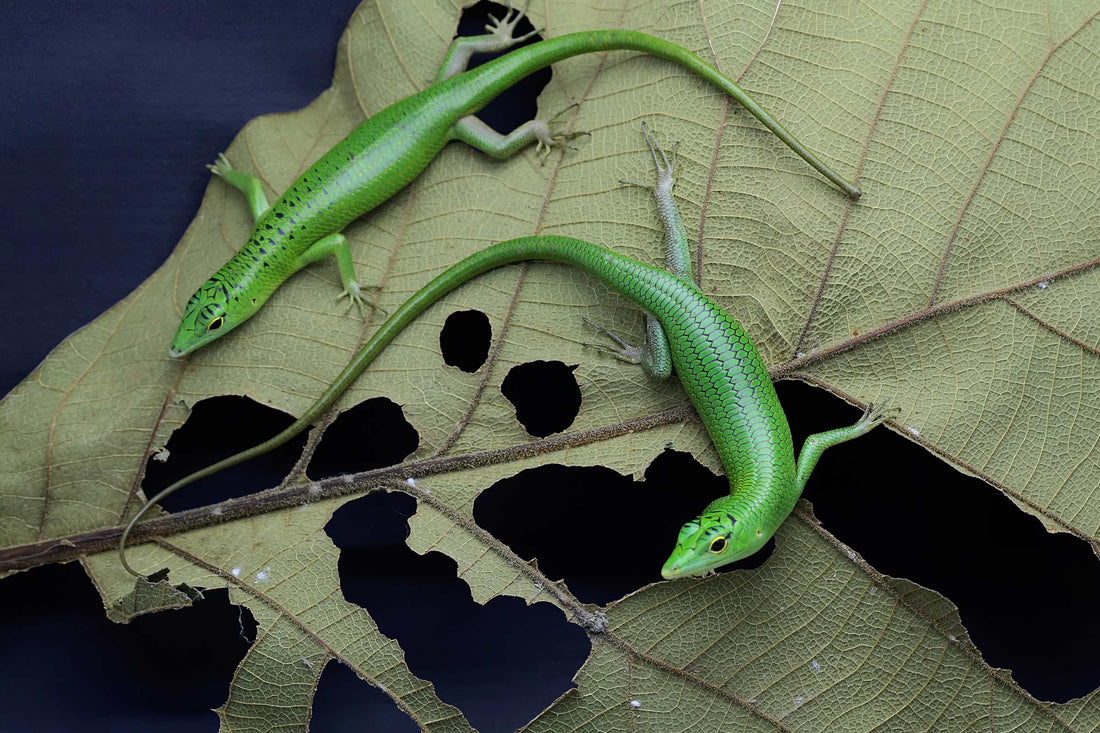Natural Habitat
Emerald tree skinks are found in tropical rainforests of southeast Asia, such as Taiwan, Philippines, and New Guinea. Emerald tree skinks are arboreal, spending most of their time above the ground in branches. Your habitat should be structured in such a way so that your skink has many opportunities for climbing and utilizing the entire volume of its habitat. Live plants and many branches of varying diameter should be considered a must. Cork tubes and flats also provide excellent climbing and hiding opportunities.
Leap Habitat Size
22”x17”x24” minimum. Larger sizes are even better!
Nutrition
Emerald tree skinks are primarily insectivores, meaning they mostly eat insects. They will also eat several different types of fruit and fruit based gecko diets. Feeding your emerald tree skink as wide a variety of insect prey as possible is best. Suitable feeder insects include: crickets, mealworms, superworms, dubia roaches, and silkworms. Your feeder insects should be fed with a high quality calcium rich diet to “gutload” them and make them more nutritious for your pet skink. Feeder insects should also be lightly dusted with a pure calcium supplement at almost every feeding. The feeders should also be dusted with a multivitamin supplement twice a month. Feed your skink during the day when it is active so it receives the benefits of the supplement powder before the insects remove the powder from themselves. Juvenile emerald tree skinks can be fed every day and adults three times a week. The number of insects will vary greatly depending on the type of insect and the age of your skink. In general feed as many insects as your skink will eat in ten minutes.
Five Parameters
-
Daylight/photoperiod
Emerald tree skinks are strictly diurnal, or day active. They experience some seasonal variation in lighting in their natural habitat and that should be replicated in your home. We recommend that your Leap LED lighting is on for 13 hours a day in the summer, 12 hours a day in the spring and fall, and 11 hours a day in the winter.
-
UV/photoperiod
The necessary duration of UV lighting is still being researched and UV certainly isn’t at peak levels throughout the day. At this time we recommend that the UV light is on for four to six hours a day around midday.
-
Heat
In general a “hot” side of the habitat should be provided and reach temperatures of 85-90 F. The middle of the habitat can be in the mid to high 70s and the “cool” side should be in the low 70s. Using tall bushy plants such as Ficus benjamina are great as they allow the skinks to escape light and heat. A dedicated heat bulb is usually necessary for this species. A low to medium wattage halogen bulb (40-60 watts) can be used as this is our best current technology at replicating the natural heating benefits of the sun. We recommend that your heat bulb should be on for approximately six to eight hours a day around midday. A basking spot of 90-100 F is ideal.
-
Water/Misting
Emerald tree skinks will primarily drink by lapping up rain or dew droplets. They may use a water bowl so a small clean water bowl can be provided at all times. We have not observed our skinks using the bowl though. Emerald tree skinks experience a wet and a dry season in nature. For half of the year you should use your Leap misting system for longer durations and for the other half of the year less so. It’s hard to approximate a rain schedule as everyone’s home conditions are different. In general a rain just before lights out and immediately after lights on is a good place to start. However, since they are tropical, even the “dry” season should be more wet and humid than the average home.
-
Humidity/Fogging
During the wet season emerald tree skinks should be provided with a daytime humidity of 60-70% during the day and 80-100% at night. During the dry season a daytime humidity of 50-60% is appropriate with an increase to 70-80% at night. This can be most easily accomplished by fogging for an extended period at night but not during the day.
Handleability/Pet metric
Emerald tree skinks can be very bold and are excellent display animals but they should not be considered a pet that you will frequently handle. There are exceptions to this as some emerald tree skinks readily seek to leave their habitat to be handled and to explore. Do not forcibly restrain your skink. Allow it to climb onto your hand and then place one hand in front of the other as it crawls. Keep your skink close to a surface like a table or the floor in case it leaves your hands. You don’t want your skink to fall far. Remember, even a foot off the ground is a considerable height to a small lizard. Emerald tree skinks are very prone to jumping and are very fast so be prepared! This is not an animal that should be handled by young children. Any handling done by older children should be supervised by an adult.
Difficulty
Intermediate. Due to their hardy nature and small size, emerald tree skinks represent an excellent display animal. However, they do require specialized care and are less forgiving of mistakes than other beginner reptiles. They are also very fast and can be flighty. They are an excellent choice for anyone with some reptile experience.

